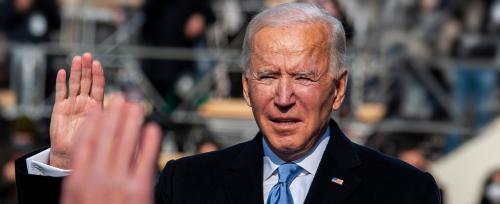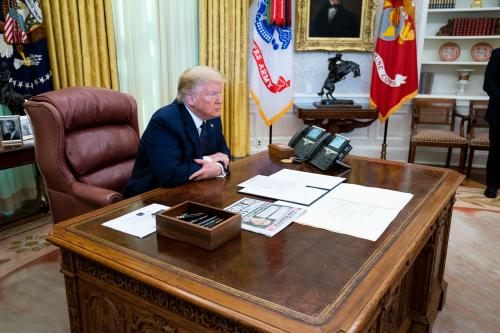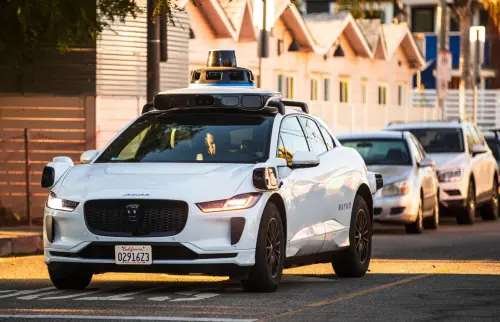By 2017, nearly all Republican politicians, including President Trump, believed that the Obama administration had overreached in the sphere of regulatory policy, with scores of regulations in need of rolling back. Indeed, deregulation was a central priority of Trump’s administration. “We slashed more job-killing regulations than any administration had ever done before,” Trump claimed in his farewell address. Putting aside all questions of whether Trump’s deregulatory agenda was good or bad for the country, it seems that it should be rather straightforward to determine whether this claim is accurate. To what extent did the Trump administration succeed in reversing the regulatory achievements of Barack Obama and his predecessors, and to what extent should such claims be understood as bluster?
Answering this question turns out to be harder than it first seems. There is no question that the Trump administration added far fewer new regulations than its predecessors. By the reckoning of the regulatory researchers at the American Action Forum, whose work is based on cost reports in agencies’ own regulatory impact analyses, on average the Trump administration imposed annual net regulatory costs of $10 billion, compared to $111 billion for the Obama administration and $43 billion for the George W. Bush administration. But wiping existing regulations from the law books is considerably more difficult than declining to take new actions. Most deregulatory actions must go through the same procedures as regulatory actions, including a notice and comment process. Most crucially, agency final actions are generally subject to judicial review, and the majority of the Trump administration’s important deregulatory actions were litigated immediately.
Those legal challenges are what make it difficult to assess the Trump administration’s deregulatory actions. The administration’s own reckonings of cost savings from deregulation—which they put at $198.6 billion by the end of 2020—were not adjusted to take account of those deregulatory actions that were struck down in court, which was a remarkably regular occurrence. The Institute for Policy Integrity tracked the Trump administration’s record in court throughout Trump’s four years in office. By its count, the administration was “successful” 58 times, and “unsuccessful” 200 times. That is, just 22 percent of the Trump administration’s regulatory or deregulatory actions that were challenged in court came through the legal process unscathed.
The Brookings Institution Center on Regulation and Markets maintained its own Tracker of the Trump administration’s regulatory changes over the course of the administration, and it provides a valuable perspective on how successful these efforts were. Rather than attempting a comprehensive accounting of all administration actions, the Brookings Tracker primarily focused on particularly significant actions that furthered the administration’s deregulatory agenda. A team of Brookings staff went through every issue of the Federal Register to find relevant, impactful actions aimed at deregulation and produced summaries of the actions.
What made the Brookings Regulatory Tracker in the Trump era unique is that it covered actions over a long period of time. It linked regulatory changes under Trump to their regulatory antecedents in the Obama administration, and then it followed the actions through to their conclusion, including the results of any litigation challenging the administration’s action. For citizens, journalists, or researchers hoping to understand what deregulation the Trump administration actually achieved, and not just what it set out to do, the Brookings Tracker is an invaluable resource. The Tracker has now been relaunched for the Biden era, where it continues the tradition of following regulatory actions between administrations. It includes major regulatory actions taken by the Biden administration as well as an archive of actions from the Trump era.
By the end of the Trump administration, the Tracker already contained four years’ worth of material—a tremendous repository of information, but one that is admittedly rather daunting to analyze. In this report, we present an overview of what we judge to be the most significant and controversial rules and code them for various characteristics, including the outcomes of legal controversies.
In answering the question of whether Trump was able to achieve his deregulatory agenda, the results are decidedly mixed. As the Institute for Policy Integrity’s tracker led us to expect, the Trump administration’s deregulatory efforts fared quite poorly in court. This undoubtedly blunted their effectiveness to a significant degree. At the same time, these actions did not fail completely in moving policy away from where the Obama administration left it. In many cases, even when the Trump administration suffered decisive losses in court, it often still succeeded in weakening, if not erasing, Obama administration policy.
To give one example, take the Clean Power Plan, the rule governing greenhouse gas emissions from existing power plants that the Obama administration finalized in 2015 as one of its signature initiatives to combat climate change. With Trump’s election, it was obvious that the Clean Power Plan would not be implemented (especially since the rule was stayed by the Supreme Court in February 2016). In March 2017 the new president issued an executive order that laid out a roadmap to its reversal. But the procedural work of dismantling the old rule and replacing it with a new one was laborious and anything but straightforward. In October 2017, the Environmental Protection Agency (EPA) proposed a rescission of the old rule, in August 2018 they proposed a new one, and in July 2019 they finalized both. They were immediately sued by a group of states and environmental groups, and on the very last full day of the Trump administration, two out of three judges on a D.C. Circuit Court of Appeals panel declared the new rule unlawful. Had Trump been reelected, the case would almost certainly have gone to the Supreme Court.
As things stand, however, the Biden administration could not pick up where the Obama administration left off. Thanks to the goals it set for emissions reductions, the Clean Power Plan was a time-sensitive rule, and being derailed for four years would have rendered the original rule meaningless or required it to be rewritten with a restructured timeline. More to the point, the Trump administration’s rescission of the old rule was not wiped out by the court’s ruling. Even though their new rule was decisively rejected, the old rule was not automatically restored. As of early 2022, the Biden administration is left with an unfulfilled statutory mandate to regulate power plants’ greenhouse gas emissions under the Clean Air Act. In its early days, the new administration announced that it would not try to revive the old rule, and the D.C. Circuit gave its blessing to that strategy. Further complicating this matter, the Supreme Court is belatedly considering the merits of EPA’s legal justification for the Clean Power Plan, hearing oral arguments in West Virginia v. EPA in February. There is a good chance that a majority may significantly constrain the kind of rule EPA will be permitted to issue to regulate greenhouse gas emissions from power plants.
This example is indicative of why a mixed picture of Trump’s deregulatory agenda emerges. On the one hand, if we are looking at wins and losses in court, the record is clear that courts ruled against the legality of the Trump administration’s deregulatory actions. The Trump administration’s lawyers were not happy with this outcome. On the other hand, if we want to know whether the Obama rule ultimately survived the Trump administration, the answer is that it did not. What prevailed at the end of the Trump administration was regulatory uncertainty.
In the study that follows, for each distinct policy issue we attempt to quantify what became of the Obama administration rule (when such a rule was specifically targeted) as well as whether a Trump administration rule was successfully instituted as of January 20, 2021.
Methods and data
All the way through the Trump administration, the Brookings Center on Regulation and Markets regularly added and updated entries for “Tracking deregulation in the Trump era.” By scanning the Federal Register every day, the Brookings team collected a huge amount of information. In total, the Tracker includes 321 actions, including 16 repeals under the Congressional Review Act, nine guidance documents, and 284 rulemakings. In order to provide context for the Trump administration actions, 69 of the rules included originated during the Obama administration. Of the 213 rulemakings in the dataset originated during the Trump administration, 115 (53.9%) were classified as deregulatory under Executive Order 13771. The Trump administration initiated 40 of those rulemakings in 2017, 80 in 2018, 52 in 2019, 40 in 2020, and one in 2021, and successfully finalized 126 of them before leaving office. The largest categories of Trump rulemakings were environment (77), Children, Youth, and Families (32), Health (28), Labor (28), Financial (20) and Transportation (20). The agencies most frequently involved were the EPA (36), Department of Transportation (25), Department of Health & Human Services (22), Department of the Interior (22), and the Department of Labor (21).
In an attempt to focus on the most important deregulatory actions, we selected a subset of the Tracker’s entries for analysis. We included every entry that was marked as “Noteworthy” in the Tracker, which were generally actions that had received mainstream news coverage. We then included other rules that were subject to litigation or significant media attention, which we gauged based on coverage by major news outlets.
Since the presence of litigation was one of the major factors leading to inclusion in our dataset, we will not be able to make any generalizations about the Trump deregulations’ propensity to end up in court, nor about their performance there. But this is not our purpose—indeed, the Institute for Policy Integrity’s tracker already does an excellent job tallying the results of court challenges. Instead, we are trying to follow the most important rules from their conception through to the end of the Trump administration.
We coded 55 Tracker entries: 50 agency rulemakings, three guidance documents, one agency order, and one Amended Endangered Species Act maintenance plan (for the sage grouse). For each of these entries, we recorded the following data:
- the cabinet-level agency responsible (with multiple entries allowed if agencies were working jointly)
- whether the rule was flagged as a deregulatory action under Executive Order 13771
- the dates of the earliest and latest Trump administration actions
- whether an Obama-era rule was being specifically targeted and, if so, whether it was not at all, partially, or completely eliminated as of January 20, 2021
- whether the Obama administration rule was challenged in court and, if so, whether it was fully or partially overturned
- whether the Trump administration had a new rule in place as of January 20, 2021, or if their attempt was partially or entirely rejected in court, or left unrealized for some other reason
- whether the Trump administration rule was challenged in court and, if so, whether it was fully or partially overturned, or whether litigation was still pending as of the end of the administration
- How many check marks (representing litigation victories) and x’s (representing litigation losses) the Policy Integrity Institute assigned to cases related to the entry.
Characteristics of the data
The agency involved with the most actions was the EPA (12), followed by the Department of Labor (10), Department of the Interior (8), Health and Human Services (7), the Department of Education (5), and the Federal Communications Commission (4). A variety of other agencies were represented in one or two actions.
| Number of Rules by Agency | ||
| Agency | Agency | Number of Rules |
| EPA | Environmental Protection Agency | 12 |
| DOL | Department of Labor | 10 |
| DOI | Department of the Interior | 8 |
| HHS | Department of Health and Human Services | 7 |
| DoEd | Department of Education | 5 |
| FCC | Federal Communications Commission | 4 |
| DOT | Department of Transportation | 2 |
| HUD | Department of Housing and Urban Development | 2 |
| Treasury | Department of Treasury | 2 |
| CEQ | Council on Environmental Quality | 1 |
| CFPB | Consumer Financial Protection Bureau | 1 |
| DOD | Department of Defense | 1 |
| DHS | Department of Homeland Security | 1 |
| DOJ | Department of Justice | 1 |
| IRS | Internal Revenue Service | 1 |
| OCC | Office of the Comptroller of the Currency | 1 |
| SEC | Securities and Exchange Commission | 1 |
| USDA | Department of Agriculture | 1 |
Of the 55 actions, 33 were flagged as deregulatory actions under Executive Order 13771.
In terms of timing, 31 of our cases saw their first Trump administration action taken in 2017, 12 in 2018, eight in 2019, and four in 2020. As we will see, the success rates varied significantly based on timing. Our last-logged actions came in 2020 or 2021 for about half our cases, while the other half were resolved earlier in the administration.
Of the 55 actions, 37 were coded as targeting a specific Obama administration rule. Of those Obama administration rules, 23 were challenged in court, with 9 completely upheld, 10 partially overturned, and 4 overturned completely. In 44 cases, the Trump administration was attempting to put a new rule in place. (In 11 cases, their aim was solely to remove the Obama administration rule.)
How much did deregulation succeed?
What is the overall portrait, then? For these critical deregulatory actions, did the Trump administration succeed in fulfilling its objectives, even after accounting for the work of the judiciary?
The results are truly mixed, though it is clear that it would be a mistake to think of the Trump administration as simply having been thwarted by its legal challenges. The Trump administration’s attempt to remove or alter the Obama administration rule was only completely unsuccessful in three cases, partially successful in seven cases, and fully successful in 27 cases.
In the 44 cases where the Trump administration was attempting to put a new rule in place, their attempt was completely unsuccessful in six cases, partially successful in four cases, and completely successful in 34 cases.
Out of our 55 cases, Trump actions ended up in court in 39. The Trump rule was upheld in eight cases, partially overturned in six cases, and completely overturned in nine cases. In 16 cases, matters were still pending at the end of the administration. For the sake of comparison, among all our actions, cases involved yielded 29 “x’s” and 8 “check marks” from the Institute for Policy Integrity. In a number of cases, we code court outcomes that they marked as administration losses as mixed results.
Stepping back and generalizing our findings, we can say that as of January 20, 2021, most of the Obama administration rules targeted for deregulation in our sample dataset were altered in the manner that the Trump administration aimed for. This remark comes with several caveats, however. First, while our selection process ensured that the changes we were looking at were important and controversial, we coded for whether the administration fulfilled its objectives—and that does not always mean total erasure of a previously existing rule. Second, many matters remained in legal limbo at the end of the Trump administration. Although these fights would have played out to completion had Trump won reelection, most will be (or already have been) anticlimactically defused during the Biden administration. In some cases, such as the Strengthening Transparency in Regulatory Science Rule (sometimes referred to as the “Secret Science” rule), courts have granted the new administration’s motion to vacate the earlier rule and instructed the agencies to refashion the rule as they see fit. For other rules, the new administration may be able to suspend implementation of the rule pending a legal result while simultaneously working to slow down court proceedings or take other executive-centered measures to nullify the effectiveness of old rules.
Some agencies were far more successful than others in making their deregulations stick. The Department of the Interior stands out as particularly unsuccessful in court. All eight of its actions that we tracked ended up in court. Three matters were still pending at the end of the Trump administration. Of the remaining five, just one was upheld entirely, one was partially overturned and three were completely overturned. The EPA’s actions proved remarkably difficult to resolve in a timely manner. All 12 of the agency’s actions we included were challenged in court, but just two had completed their legal process entirely by January 2021. (Several matters were likely headed to the Supreme Court.)
One interesting finding is that the actions commenced earlier in the Trump administration were less likely to be successful. Six new Trump administration rules out of 24 where action commenced in 2017 were eliminated entirely. Likewise, the three instances where the Trump administration entirely failed to alter the Obama administration rules they targeted all began in 2017. However, this may well be an artifact of the legal process; rather than the characteristics of these actions being different, they may simply have been the only ones in which the legal process was able to play itself out entirely.
Conclusions
There is no single vantage point from which one can definitively evaluate the Trump administration’s deregulatory efforts. Different inquirers coming at different aspects of these activities quite understandably come away with different impressions. By transforming information contained in the Brookings Trump Regulatory Tracker into a novel dataset, we have provided a new perspective. While the Trump administration’s legal difficulties certainly limited the extent to which they were able to realize their deregulatory goals, it is also clear that in most matters they succeeded in significantly altering the status quo as of the end of the Obama administration.
In closing, we should emphasize that success as of January 20, 2021 is certainly not equivalent to enduring policy change. A year into his term, President Biden and his administration have made reversing the Trump administration’s deregulations a major policy priority. In a January 20 executive order President Biden directed agency heads to review all rules promulgated by Trump administration officials and listed 104 rules that agencies should specifically target for removal. As of the time of writing, the Brookings Regulatory Tracker (updated for the Biden presidency) has tracked action by the Biden administration to delay, overturn, or replace 26 rules passed by the Trump administration. Many of these efforts are already in effect. For example, the Biden administration has repealed such high-profile rules as the Scientific Transparency Rule, the Benefit-Cost Rule, weakened CAFE standards, and revised guidance on transgender rights under Title IX. Three of Trump’s deregulations were successfully targeted for rescission through the Congressional Review Act. Of course, assessing the success of this new administration’s regulatory efforts, including seeing how they fare in court, must await another day
The Brookings Institution is financed through the support of a diverse array of foundations, corporations, governments, individuals, as well as an endowment. A list of donors can be found in our annual reports published online here. The findings, interpretations, and conclusions in this report are solely those of its author(s) and are not influenced by any donation.
-
Acknowledgements and disclosures
The authors thank Siddhi Doshi for research assistance and Becca Portman for help with data visualization.
The Brookings Institution is committed to quality, independence, and impact.
We are supported by a diverse array of funders. In line with our values and policies, each Brookings publication represents the sole views of its author(s).












